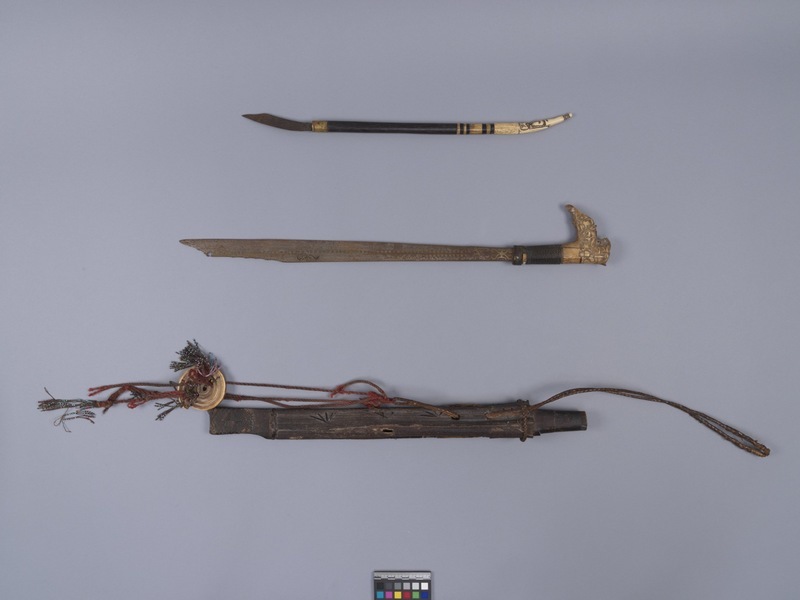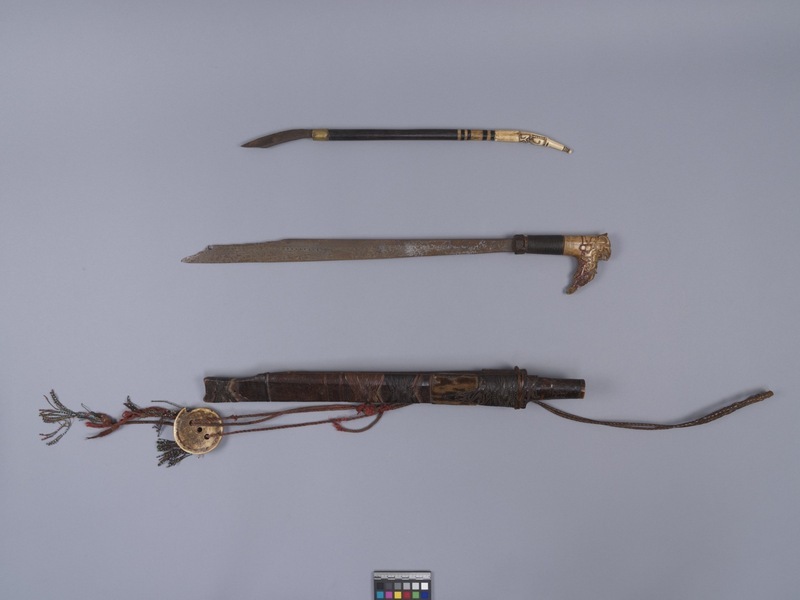Knife Item Number: 3329/1 a-c from the MOA: University of British Columbia


Description
Long knife (part a), with a small knife (pisau raut; part b), and scabbard (part c). The knife blade is convex on one side and slightly concave on the other side, and is decorated with inlaid brass in a series of circles and vines. The blade itself gets gradually wider and then tapers in forming a point in line with the cutting edge. The grip is wrapped with finely woven fibre. The hilt of horn is elaborately carved, with red pigment in the lines, and has two drilled holes for an attachment. The whittling knife (part b) has a small curved blade of steel, with a brass cap marked with illegible text. The shaft is of a dark brown wood which transitions into alternating rings of horn and wood. The slightly curved hilt is elaborately carved. The scabbard is composed of a wood sheath for the sword, and an attached bark sheath for the knife. The wood sheath is composed of two pieces of wood, bound together by woven plant fibre and animal skin. The locket(?) is ornately carved. There is a long carrying strap of plaited plant fibre, and an ornament of shell and thin tassels with beads of pink, blue, green, red and yellow.
Narrative
Collected during a business trip to West Kalimantan in 1986. The traveler took a boat from Pontianak, on the Kapuas River, to a small village, where he purchased the mandau.
Item History
- Made in West Kalimantan, Indonesia
- Collected during 1986
- Owned by John Jeremy Caddy before November 9, 2018
- Received from John Jeremy Caddy (Donor) on November 9, 2018
What
- Name
- Knife
- Identification Number
- 3329/1 a-c
- Type of Item
- knife
- Material
- steel metal ?, brass metal ?, horn ?, plant fibre, shell, wood, animal skin, resin, bark, glass and cotton fibre ?
- Part A
- height 61.3 cm, width 8.4 cm, depth 2.5 cm
- Part B
- height 47.1 cm, width 3.0 cm, depth 1.6 cm
- Part C
- height 82.5 cm, width 5.5 cm, depth 5.8 cm
- Overall
- height 82.5 cm, width 8.4 cm, depth 5.8 cm
Who
- Culture
- Bidayuh ?
- Previous Owner
- John Jeremy Caddy
- Received from
- John Jeremy Caddy (Donor)
Where
- Holding Institution
- MOA: University of British Columbia
- Made in
- West Kalimantan, Indonesia
When
- Collection Date
- during 1986
- Ownership Date
- before November 9, 2018
- Acquisition Date
- on November 9, 2018
Other
- Item Classes
- metalwork
- Condition
- fair
- Accession Number
- 3329/0001 a-c